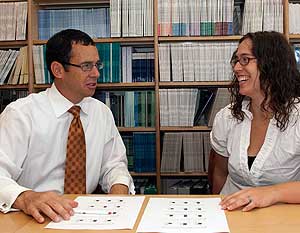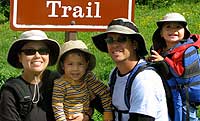Laundromats and community newspapers can be the first line of defense against cancer. What happened to diet, exercise and other healthy behaviors?

“Cancer prevention information is available, but it isn’t truly powerful unless it gets to everyone,” says Matthew W. Kreuter, Ph.D., professor at the George Warren Brown School of Social Work.
“We have these tremendous gaps in our country between the health status of the wealthiest and the poorest people,” Kreuter says. “For me, helping to close the gap is the greatest priority in the work that I lead. It just boils down to the issue of social justice. What it means to be a healthy community and a great society is that you don’t have such wide disparities in the health of the population.”
Kreuter is the founder and director of the Brown School’s Health Communication Research Laboratory (HCRL), which works to increase the reach and effectiveness of health information for low-income and minority populations.
“What we try to do is make information about health every bit as interesting, compelling, personally relevant and easy to understand as anything you might encounter in your everyday life,” Kreuter says.
“I think historically ‘we’ — being health and medical professionals — haven’t done a very good job of that,” he says. “What we need to do is make health information and healthy living as easy for people as possible — easy to understand and easy to act upon.”
The current direction of the HCRL is to use technology to connect people to existing programs and services that can help them.
Kreuter and his team built computer kiosks designed to deliver breast cancer information and put them in beauty salons, Laundromats, health centers, churches, social service agencies and public libraries. Testing revealed that Laundromats offered the best access to women who need this information the most.
“We’ve had success with the kiosks for the last five years and are constantly striving to improve them,” Kreuter says. “The newest version of the kiosks will have telephones connected to cell-phone technology. When a woman using the kiosk indicates that she has never had a mammogram or that she hasn’t had one in the last two years, the phone will ring, and on the other end will be a person from a local health center that provides mammograms who can schedule an appointment for her and come and pick her up if necessary.”
Another expanding project is the HCRL’s work with African-American newspapers across the country to help them integrate more cancer coverage into their newspapers.
“African-Americans have higher rates of cancer and cancer death than other populations,” Kreuter says. “It was important to find a way to get information to this population, and black newspapers provided a way to do that.”
The HCRL created a news service that provides cancer stories to these newspapers. Each story is specific to each newspaper’s community.
“What we’ve found in the first five years of doing this project was that offering this news service significantly increased cancer coverage in these black newspapers, and that readers of those papers made some changes as a result of it,” Kreuter says.
In a second phase of the project, the HCRL is partnering with the American Cancer Society (ACS) to make the cancer stories even more localized. Local staff members at ACS offices around the country will gather local pictures, quotes and facts for the news service to further customize each story for their community.
Culture shift
The HCRL’s Center for Cultural Cancer Communication is one of only five centers of excellence in cancer communication research nationally, as designated by the National Cancer Institute.

“I think there is an increasing awareness among people in health and medical fields that we need to do a better job of communicating with those we serve,” Kreuter says.
“There is a growing demand for tools and approaches and resources that can help us do a better job in interacting with the public and with patients,” he says.
Kreuter, who holds a secondary appointment with the School of Medicine, notes that this shift among health professionals is welcomed.
“There are still a lot of folks who think of communication and education as the pamphlet rack outside their waiting room,” he says. “They don’t think of communications as innovative or scientific or able to change how people think and act — but it can do all of those things.”
Coming full circle
Kreuter always has worked in communications but not always in health. In fact, his first job after graduating with a bachelor’s degree in English from the University of Utah was at Washington University’s Office of Sports Information.
“For five months in 1986, I traveled around the Midwest on team buses covering the University’s sports teams,” he says.
“After that, I worked in media relations at another university and had some good success there, but I still felt like I wanted to have more social impact, and I didn’t quite know how to do that,” he says.
Kreuter found his direction while studying health behavior and education at the University of North Carolina at Chapel Hill.
|
Matthew W. Kreuter |
|
Title: Professor, George Warren Brown School of Social Work and School of Medicine Education: B.A., English, University of Utah; M.P.H. and Ph.D., health behavior and health education, University of North Carolina at Chapel Hill Family: Wife, Charlene; sons Cal, 4, and Will, 2 Favorite vacation stop: Montana |
“I was no longer promoting sports teams or university research; instead, I learned how to use the same tools to encourage healthy behaviors and social action,” he says. “I’ve had a real love of the field since I entered it.”
Academia called, and Kreuter served on the faculty of Saint Louis University before joining the Brown School in 2008.
“When I was 22, I certainly did not think I would be back here, and certainly not in this capacity,” he laughs.
Rather than focusing on athletics, Kreuter now is an integral part of the University’s public health initiatives. He currently serves as a member of the Faculty Advisory Council for the University’s new Institute for Public Health.
“Being a part of public health at the University has been very exciting, and I think the most impressive part of it, to me, has been the insistence of University leadership that public health be a campus-wide effort across disciplines,” Kreuter says.
“One of the things that really appeals to me about the University’s approach is that we’re really viewing public health as not just a series of traditional public health disciplines but rather a series of problems that require many disciplines to address them effectively,” he says. “It’s a unique approach nationally, and it’s going to prove to be a very effective approach.”
Since joining the Brown School, Kreuter also has played a lead role in the development of the school’s new master of public health degree.
“With his emphasis on impacting vulnerable populations and communities, Matt’s work truly exemplifies the intersection of public health and social work,” says Edward F. Lawlor, Ph.D., dean and the William E. Gordon Distinguished Professor.
“He has helped us create a public-health curriculum that exposes students to perspectives from a wide range of disciplines, including communications,” Lawlor says.
Outside the ‘U’
In his spare time, Kreuter enjoys the outdoors with his family, working in the yard, and hiking in Montana.
“I’ve retained my love of sports since leaving the sports information office, but I’m happy to leave the bus rides behind,” he jokes.